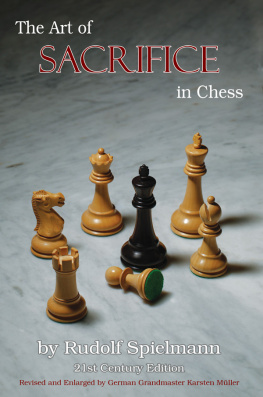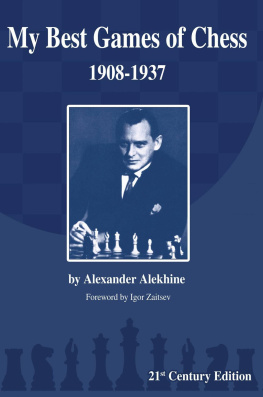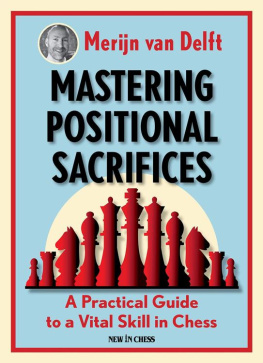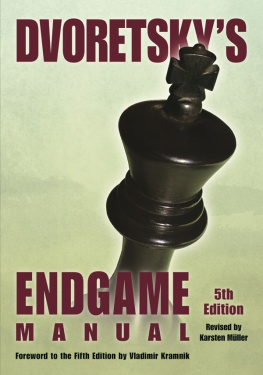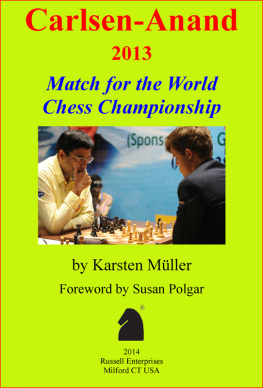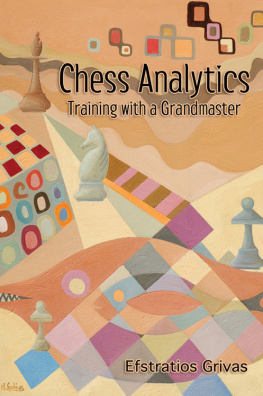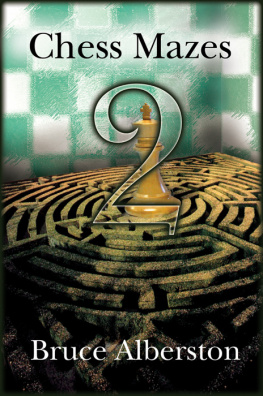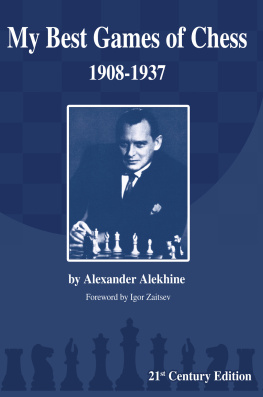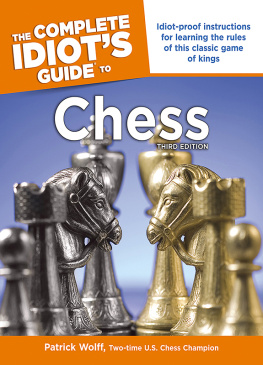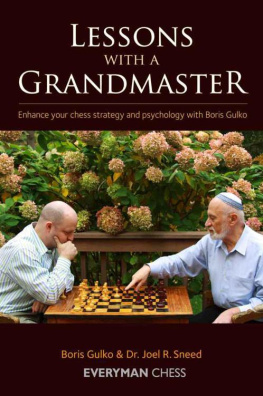The Art of Sacrifice in Chess
by
Rudolf Spielmann
21st Century Edition
Revised and Expanded by Karsten Mller

The Art of Sacrifice in Chess
by Rudolf Spielmann
Revised and Expanded by Karsten Mller
21st Century Edition
2015 Copyright Russell Enterprises, Inc.
All Rights Reserved
No part of this book may be used, reproduced, stored in a retrieval system or transmitted in any manner or form whatsoever or by any means, electronic, electrostatic, magnetic tape, photocopying, recording or otherwise, without the express written permission from the publisher except in the case of brief quotations embodied in critical articles or reviews.
ISBN: 978-1-936490-78-3
Published by:
Russell Enterprises, Inc.
PO Box 3131
Milford, CT 06460 USA
http://www.russell-enterprises.com
Cover design by Janel Lowrance
Translation of the original edition by J. du Mont
Printed in the United States of America

Table of Contents
Signs & Symbols
| ! | a strong move |
| !! | a brilliant or unobvious move |
| ? | a weak move, an error |
| ?? | a grave error |
| !? | a move worth consideration |
| ?! | a dubious move |
| = | an equal position |
 | White stands slightly better |
 | White has a clear advantage |
| + | White has a winning position |
 | Black stands slightly better |
 | Black has a clear advantage |
| + | Black has a winning position |
 | an unclear position |
| # | mate |
| (D) | See the next diagram |
| W | White to move |
| B | Black to move |
Preface
Rudolf Spielmann was born in Vienna on May 5, 1883. He was one of the top chessplayers in the world in the first part of the 20th century. His style of play, particularly in the days of his youth, was quite daring, often described as romantic. He relished combinational, sacrificial play, and this earned him the moniker The Last Knight of the Kings Gambit.
Spielmanns love of the brilliant and creative side of chess resulted in his opus magnum, The Art of Sacrifice in Chess. This seminal work was the first attempt to categorize and explain the different kinds of chess sacrifices. Although many chessplayers have since written about these same themes, in fact the original effort early established itself as a genuine classic, and it remains so today.
Written in the mid-1930s, it has heretofore only appeared in English with antiquated English descriptive chess notation. It featured 37 games played by Spielmann himself, each illustrating one or more sacrificial themes.
When the American publisher Russell Enterprises suggested the re-release of a new algebraic edition of this classic, with additional material, I was immediately enthusiastic, as sacrifices have always held a special fascination for me. But it also presented a challenge: How do you edit and try to improve a classic?
This question was partially answered by Spielmann himself. In his Epilogue to the original edition, while hoping the reader was suitably intrigued and pleased with the work accomplished, he suggested that other sacrificial topics were omitted as a result of space considerations. I did not follow his suggestion directly as this would indeed lead to a different book, as Spielmann had already pointed out.
I think that one other way to get a feeling for sacrifices is to study the patterns of the typical sacrifices on certain squares like the Greek Gift Bxh7+. I hope that this complements Spielmanns approach well and helps the reader to develop a ore general intuitive approach as well. This can not be traced back directly to Spielmanns answer, but I nevertheless hope that this way to look at The Art of Sacrifice in Chess is in Spielmanns spirit, and whenever possible I have used Spielmanns games as examples.
Furthermore, I have added chapters about the modern attacking geniuses Mikhail Tal and Alexei Shirov, both from Riga, and one chapter on the art of defense, a theme whose development has been greatly helped thanks to the computers.
The publisher was also able to provide additional insight. Drawing from the experience of having successfully released 21st-Century Editions of such classics like Laskers Manual of Chess by Emanuel Lasker, New York 1924 by Alexander Alekhine, along with many others, it was decided to not only add new material as suggested by Spielmann some 70+ years ago, but also include an examination of the original text, with corrections if necessary, and supplemented by dozens of exercises.
The original text remains intact. Spielmanns analysis was checked by one of the strongest computer programs. When there were comments to be added by me, they were integrated into the original text in blue talics . We wanted to preserve the original flair and spirit of his great work.
Spielmanns concept was initially presented in two main sections and divided into 13 chapters according to the nature of the sacrifice being discussed. This approach has been maintained with the newly added material. Seven new chapters of material and one of exercises now round off Spielmanns work.
In addition, in the spirit of the original, I have included Spielmanns games in the new material whenever possible. I have also added exercises to many chapters as I think they are very important for training purposes.
Overall, in its transition to a modern to a 21st-Century Edition, Spielmanns original effort has approximately doubled in size. There is new material, my italicized notes to the original material (hopefully the reader will not consider them too intrusive!) and more diagrams have been added. All in all, I very much hope that the final result would have pleased the Austrian grandmaster.
Please enjoy the magic of Rudolf Spielmanns chess wizardry!
German Grandmaster Karsten Mller
Hamburg
May 2015
Introduction
by Rudolf Spielmann
The beauty of a game of chess is usually appraised, and with good reason, according to the sacrifices it contains. Sacrifices a hallowed, heroic concept! Advancing in a chivalrous mood, the individual immolates himself for a noble idea.
Such sacrifice evokes our homage and admiration even where the idea as such does not meet with our full approval. In chess, which we like to view as a counterpart of life a sacrifice arouses similar feelings in us. On principle we incline to rate a sacrificial game more highly than a positional game. Instinctively we place the moral value above the scientific. We honor Capablanca, bur our hearts beat higher when Morphys name is mentioned. The magic of the sacrifice grips us and we care nothing for the accompanying circumstances whether Morphys opponents were weaker than Capablancas, how Morphy would fare today, how Capablanca would have played in those far-off days. The glowing power of the sacrifice is irresistible: enthusiasm for the sacrifice lies in mens nature.
Next page
